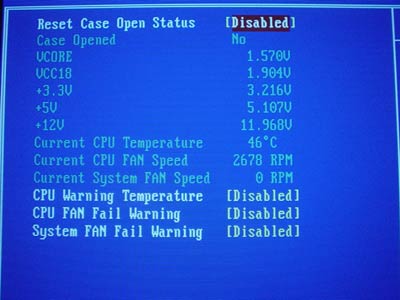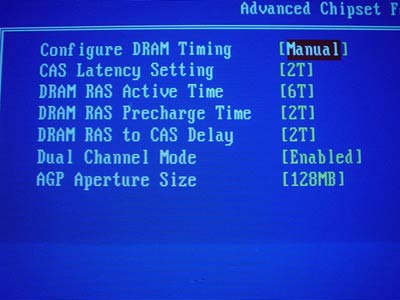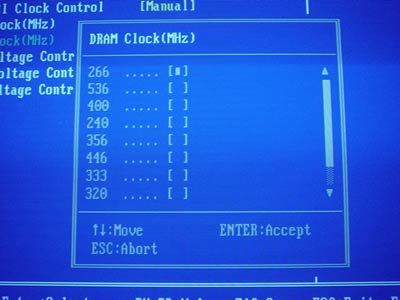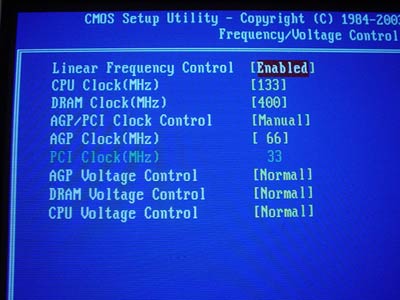Gigabyte SINXP1394 (SiS 655): More Dual Channel DDR for P4
by Evan Lieb on February 11, 2003 3:04 AM EST- Posted in
- Motherboards
Gigabyte SINXP1394: BIOS and Overclocking
Yet again, Gigabyte chooses the Award BIOS to power their high-end motherboards.

The SINXP1394’s PC Health section is pretty standard among dual channel DDR motherboard BIOSes we’ve encountered. Here you’ll find readings on CPU temperature, PSU readings (all rails) and CPU and System fan speeds. There’s also an option for setting a CPU warning temperature as well as enabling or disabling CPU fan failure warning and/or System fan failure warning. Unfortunately there are no VDIMM or VAGP readings, but those options aren’t too common to begin with.
As usual, Gigabyte hides the Advanced Chipset Features section of their BIOS, as they have in boards such as the 8SG667 (SiS 648), 8PE667 (845PE), 7VAXP (KT400) and 8INXP (E7205). Therefore, as you would do with those previously mentioned motherboards, you’re forced to press and hold CTRL while hitting the F1 key to bring up the Advanced Chipset Features section. Gigabyte hides the Advanced Chipset Features section simply because they don't want users fooling around with DRAM timings, which can potentially prevent your system from POSTing if you set those timings too aggressively.

Once you expose it, the SINXP1394’s Advanced Chipset Features section isn’t any different from Gigabyte’s other Advanced Chipset Features sections. In the SINXP1394 BIOS you’re allowed to adjust CAS Latency, Precharge to Active, Active to Precharge, Active to CMD, and several other options that don't noticeably boost performance.

One of the most anticipated aspects of SiS 655 motherboards has been their support for multiple memory frequencies. While there isn’t a single Granite Bay motherboard on the market that supports more than dual DDR266 operation, all SiS 655 boards will support at least dual DDR333 operation. Interestingly enough, Gigabyte decided to go all out and provide an option in the SINXP1394 BIOS for up to dual DDR540. Obviously you won’t be hitting anywhere near DDR540, but there is an option for dual DDR400, which can be run quite successfully on the SINXP1394.
There isn’t any real room to fool around with voltage adjustments in the SINXP1394 BIOS. VDIMM is adjustable as high as just 2.6V in 0.1V increments. This shouldn’t be a problem for your average user, but enthusiasts may be turned of by this limited VDIMM control, as 2.7V or 2.8V would help in memory overclocking (though this only applies to fanatical enthusiasts of course). VAGP is also quite limited; up to 1.6V in 0.1V increments is hardly flexible compared to most other enthusiast boards, but is an unnecessary BIOS option anyway, as VAGP doesn’t really aid AGP overclockers all that much.

The saving grace of this board is its very high Vcore potential. While 1.725V in 0.1V increments may not seem like a lot to very serious overclockers, actual Vcore will run just under 1.8V. That’s right, Gigabyte’s SINXP1394 is quite the overvolter; 1.57V on Auto (default) Vcore to be exact. That’s 1.795V if you decide to set Vcore to 1.725V in the BIOS. Certainly, you would have to be crazy to run a Pentium 4 at 1.795V with any conventional cooling for any length of time unless you’re content with frying your CPU within months (or even weeks depending on your exact setup). Still, this Vcore should suit just about anyone.
Unlike other SiS chipset-based boards, the SINXP1394 includes the much needed AGP/PCI lock. We've become accustomed to seeing this feature on 845PE boards as well as some nForce2 boards, but only recently on SiS boards.
FSB Overclocking Results
Normally we don’t see P4 boards based on SiS chipsets overclock all that well using cheap or even good overclocking setups. Intel 845PE-based boards have easily outpaced SiS 645/645DX/648 in FSB overclocking. However, we’re glad to report that SiS has modified the SiS 655 in some way as to allow a huge boost in FSB overclocking, as was initially evidenced in our MSI 655 Max review. The following table lists the components we used for overclocking the FSB using the Gigabyte SINXP1394 motherboard:
|
Front Side Bus Overclocking Testbed |
|
|
Processor:
|
Pentium
4 2.26GHz
|
|
CPU
Vcore:
|
1.5V
(actual)
|
|
Cooling:
|
Intel
Retail HSF & Thermal Pad
|
|
Power
Supply:
|
Enermax
300W
|
If some of you may have been thinking that the overclocking results we experienced with the SiS 655-powered MSI 655 Max was just a fluke, think again. Gigabyte’s SINXP1394 was able to reliably operate at 164MHz FSB, which is the second highest FSB overclock our AnandTech labs has ever overclocked a P4 board based on a SiS chipset (MSI’s 655 Max is still the highest overclocking SiS board we’ve encountered). In fact, we were able to boot into Windows XP at 168MHz FSB (which is the highest we’ve ever been able to boot into Windows on any P4 motherboard) and run a few benchmarks before the system finally froze. Coincidently, the MSI 655 Max was also able to boot into Windows XP at 168MHz FSB before finally beginning to show signs of instability. Let us remind users that our system configuration listed in the table above is a bare minimum setup for FSB overclockers. Serious overclockers should look to purchase a high-quality and high-wattage PSU in addition to copper cooling.
After having tested Gigabyte’s patented DPS (Dual Power System) add-in card with their 8INXP motherboard in mid-November, it was clear from our tests that DPS, though “transforming” the 8INXP into a 6-phase motherboard, did nothing for overclocking in our numerous stress and benchmarking tests. The same is true with DPS installed in the SINXP1394. Stability and performance were identical. In addition, we have yet to see any real reproducible evidence that confirms Gigabyte’s claim that onboard components will last longer with DPS installed in Backup mode.










0 Comments
View All Comments